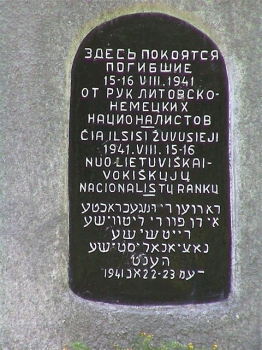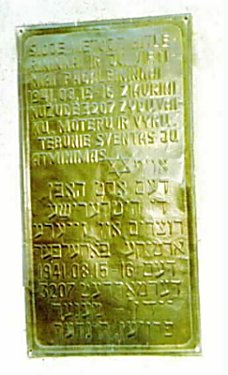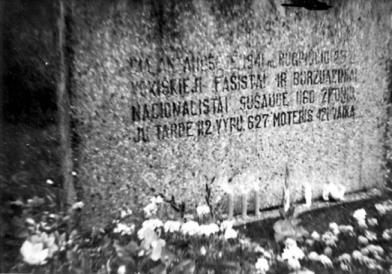Holocaust-Related Materials
from the Holocaust Atlas
On June 22, 1941, Nazi Germany attacked
Lithuania, which the Soviet Union had ruled since July 1940.
The Rokiškis
and Environs yizkor book contains accounts of Holocaust survivors
describing how the Jews in the Rokiškis
region were attacked, gathered into temporary “ghettoes,” humiliated,
starved, and subsequently shot by Lithuanian nationalists and special
German detachments.
Jewish property having useful value was
distributed by the nationalists.
The three synagogues on Rokiškis’
Synagogue Street were burned, as were many others in other shtetls
throughout Lithuania.
Most official accounts
indicate that the Jews of the Rokiškis
region were killed at four locations, specifically, the Steponiai forest
(July 1941), the Vyžuonai
forest (July 1941),
the Velniaduobė woods near the village
of Bajorai (August 15 and 16, 1941 – 3,207 men, women, and children),
and the Antanaše
forest (August 25, 1941 – 1,160 men, women, and children).
Excerpts from the Holocaust Atlas of
Lithuania
In 2010 the Vilna
Gaon State Jewish Museum and the Austrian association
Gedenkdienst (Memory Service) launched
initiated the on-line website,
Holocaust Atlas of Lithuania,
which is intended to present comprehensive information regarding each
mass-murder site in Lithuania. Following
are the Atlas’ descriptions of the massacre sites at Velniaduobė
and at
Antanašė.
1.
Velniaduobė
(Bajorai)
The Mass Murder of the Jews of
Rokiskis and Surrounding Areas at Velniaduobe Forest
About Massacre
The temporary Jewish ghetto in Rokiškis was
set up in July, 1941. It didn‘t last long: all ghetto prisoners were
shot on August 15 and 16, 1941.
Soviet
POWs were brought to Velniaduobė forest near Bajorai village about 4.5
kilometers from Rokiškis a few days before the mass murders and were
forced to dig several large pits.
Heads
of auxiliary police units, subordinate to the commandatura in Rokiškis,
were summoned there the night before the mass murder operation. They
were ordered to assemble their units secretly at the Rokiškis manor that
evening. The
next day, August 15, the commander told the units assembled in the manor
courtyard they must go to the ghetto and bring Jews in groups to the
killing site.
About
25 men from the Rokiškis Guard Unit went to Bajorai village in a truck.
The
remaining white armbanders went to the ghetto and began lining up Jews
in long lines of about 100 people each. Most Jews were marched on foot
but the elderly and small children were taken by truck and cart. The
columns were marched toward Juodupė and then turned onto a road on the
right at Bajorai village leading into the forest.
They
ordered their victims to undress before they shot them. They ordered
groups of half-naked Jews into the pits and shot them from the edge of
the pits. On
the first day Rokiškis Guard Unit people and German Gestapo did the
shooting. The
site was surrounded by white armbander units from Rokiškis, Juodupė,
Kamajai, and Svėdasai.
A
mobile unit (Rollkommando Hamann) of the Gestapo, about 12 SS troops
armed with machine guns from Kaunas, commanded the shooting.
After
they shot one group of victims, Soviet POWs laid down a thin covering of
earth over the corpses and the next group of victims was brought down
into the pit. The sound of a nearby tractor engine drowned out the sound
of gunfire.
On the first day approximately half of the
Jews in the Rokiškis ghetto were murdered.
The
mass murder operation continued the next day.
The
shooting was performed in the same manner except that the Rokiškis Guard
Unit did less shooting and auxiliary police from the rural districts and
Gestapo did more shooting.
Soviet
POWs covered the pits over with dirt.
The
Jäger Report says 3,207 people were killed on August 15 and 16, 1941, at
Bajorai village, including 3,200 Jews, 5 Lithuanian Communists, 1 Pole
and 1 partisan.
Jäger on December 1 reported on the mass
murder of the Jews of Rokiškis as a successful example of cooperation
between the German mobile unit and Lithuanian white armbanders. Members
of the Rokiškis Guard Unit each received a 150 ruble reward for their
part in the mass murder of Jews.
Several
hundred Jews from Pandėlys, 6 Jewish families from Južintai, 70 Jews
from Panemunėlis, 70 elderly, women and children from Svėdasai, 117
people from Kamajai, some of the Jews from Obeliai, 17 Jews of Maneivai
village and 20 Jewish families from Onuškis were put in the Rokiškis
ghetto .
*
*
*
Perpetrators
Rollkommando Hamann/1st Battalion 3rd Unit;
Rokiškis Guard Unit;
white armbanders from Rokiškis, Juodupė,
Kamajai and Svėdasai
Velniaduobė
(Bajorai) Memorial Plaques
In 1958, a memorial was erected at the Velniaduobė
site with the following plaque, which
states in
Russian, Lithuanian, and Yiddish, “Here rest
those killed on August 15-16, 1941, by Lithuanian-German nationalists.”
The Yiddish text provides the Hebrew calendar dates, and thus,
the yahrzeit dates, as Av 22-23 [5701].

The following photograph
was taken in 1997 of a metal sign that also marked the Velniaduobė
massacre site.
The sign stated, in
Lithuanian and Yiddish, “In
this place Hitlerists and their local helpers on August 15 and 16, 1941
cruelly killed 3207 Jews - children, women, men.
Let the memory of them be blessed.”

2.
Antanašė
Mass Murder of the Jews of the
Rokiskis Region Near the Near the Antanase Manor
About Massacre
Some of the Jews of the Rokiškis region
(mainly women and children) were held in the summer of 1941 at Antanašė
manor near Obeliai.
On
August 25, 1941, about 30 Rokiškis Guard Unit troops and several German
Gestapo officers arrived at Antanašė manor from Rokiškis.
The
night before the mass murder operation, Soviet POWs dug two large pits
at the edge of Degsnė forest (about 1.5 kilometers from the manor).
Obeliai
municipal and railway station auxiliary police were placed as guards on
the road from Antanašė manor to the killing site.
Other
Obeliai white armbanders marched the Jews in large groups (of about 100
people). In
total, about 120 to 160 Rokiškis Guard Unit troops and Obeliai rural
district auxiliary police perpetrated the mass murder (including
transporting and guarding Jews as well as shooting them). They ordered
Jews to undress before they shot them.
Executioners
from Rokiškis and several Gestapo did the shooting.
The mass murder operation lasted an entire
day. The Jäger Report says 1,160 Jews were killed at Antanašė, including
112 men, 627 women and 421 children. Thirty policemen from Obeliai, 23
from Obeliai railway station, 13 from Aleksandravėlė and 12 from
Kriaunos auxiliary police unit received rewards of 100 rubles each for
the mass murder operation.
*
*
*
Perpetrators
German Gestapo;
Rokiškis Guard Unit;
Obeliai municipal and railway station
auxiliary police;
Obeliai white armbanders;
Aleksandravėlė and Kriaunos auxiliary police
Antanašė
Memorial Plaque

Yad Vashem Archives, Photo Collection No. 404
Professor Alfonsas Eidintas’ Description of
the Murders at
Velniaduobė
(Bajorai)
Professor Alfonsas Eidintas, a historian,
served as ambassador to the United States from 1993 to 1997 and later
served as Lithuania’s ambassador to Israel.
His
book entitled “Jews, Lithuanians, and the Holocaust, [English
translation of
Žydai,
lietuviai ir holokaustas, Leidykla Vaga (2002)], Versus Aureus (Vilnius
2003), includes the text of his 2002
address to the Lithuanian Seimas (parliament),
which described the murder of the Jews in Rokiškis
as follows:
The story of witness Brunius, recorded by
Secretary General of the Lithuanian Nationalist Party Zenonas Blynas in
1941 testifies what the massacre in Rokiškis
looked like – and it was exceptional, because observers were allowed to
watch it, “Half naked Jews had to jump into a three-meter deep trench.
They were shot at by killers walking
around the trench.
Brains and blood spattered everywhere.
The killers were soaked in blood.
[…]
People from the area came to watch.
At first they laughed and smiled and
were satisfied, but later, women (Lithuanian)[]
began
screaming in horror.
A slaughter, how vile.
The [administrative] governor of the
district is Judas.[]
I had said that if Germans made us do it, everything had to be
done quietly, in secret and without any scandal.
That degenerate did quite the
opposite.”
-- Jews, Lithuanians, and the Holocaust, p.
500.
In the same book, Eidintas noted that in
November 1965, the Soviets put on trial five individuals who were
“parties to the killings in Rokiškis,”
specifically, Kazimier[a]s Dagys. Steponas Lašas,
Stasys Varnas, and Petras Strumskis.
He added that news articles at the time
observed that four other “members of the Rokiškis
command company” who fled to the West after the Second World War,
namely, “in the United States – Henrikas Dūda
and Andrius Abarius, in Australia – Balys Milaknis, and in Canada –
Vladas Erslovas. [footnote 54: S. Laurinaitis, “Kaltina nužudytieji,
smerkia gyvieji” (Those who were murdered accuse, those who survived
condemn), Tiesa, 7 November 1965.]
As of 2017, post-Soviet
Lithuania has not successfully prosecuted any perpetrator.
[7]
|
